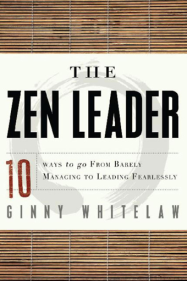 As leaders, we all make a conscious effort to walk the talk, especially when it comes to implementing change. Showing others that we follow through on our thinking with our own action sets the pace for others to follow. But sometimes this turns into a very short walk. We can lose momentum, get sidetracked, run into obstacles, or even get frustrated and turn back. Walking the talk is not an easy stroll in the park.
As leaders, we all make a conscious effort to walk the talk, especially when it comes to implementing change. Showing others that we follow through on our thinking with our own action sets the pace for others to follow. But sometimes this turns into a very short walk. We can lose momentum, get sidetracked, run into obstacles, or even get frustrated and turn back. Walking the talk is not an easy stroll in the park.
I am in the middle of such a walk right now. Last month I attended a program at the Institute for Zen Leadership (IZL). This was a 4-day immersion in how to make difficult "flips" that can greatly enhance my leadership skills, along with an introduction to zen meditation. I've read enough about the benefits of meditation to know that this could help me immensely, so I went. For the 4 mornings that I was there, sitting on my cushion with the other small group of leaders who had come for the same purpose, I wasn't just doing it, I was enjoying it. I liked how clear my mind became, how refreshed and energized I felt, and I was determined to make this a real practice in my life.
Then I returned home.
I don't need to tell you how quickly this "practice" fell off. Time became my biggest excuse, aided by a dose of procrastination. What struck me is how difficult it is to walk the talk. As agents of change, we are expected to lead the march without faltering. How can I expect others to keep taking those steps if I don't keep moving forward at a sustained pace myself? So, I've put together a few suggestions that have helped me walk the talk, or continue the journey down a difficult path.
Push through the pain and just DO IT!
I know this seems like I'm stating the obvious, but take a lesson from our greatest athletes and push through whatever resistance gets in your way - including yourself. As Ginny Whitelaw (author of The Zen Leader and director of the IZL program I attended) would say, "Get out of your own way!" This might be a "flip" in consciousness, like getting out of coping mode… or a fierce desire to see it through. Find your resolve and determination that came with the original idea and keep putting one foot in front of the other.
Don't think about it and just DO IT!
This may seem equally obvious, but recognize that your thoughts can be the greatest procrastinators. Move beyond the question of whether you're going to do it or not do it - similar to brushing your teeth in the morning. Once you shut down the internal debate and simply do what you said you were going to do, you'll find it's much easier than thinking about it.
Make small rewards along the way
If it's hard for you to keep the momentum going, imagine how hard it is for others who are now in pace behind you? Define some milestones that are quickly attainable and reward them (and yourself) once they get there. This is no different than breaking down an insurmountable task into bite-size pieces. Keep your eye on the end goal, but make it a series of walks, not just one long marathon… and celebrate the little victories along the way.
Keep smiling
A positive attitude works. Don't have it today? Fake it… and keep faking until it comes naturally again. People are looking to you for inspiration. When they see you smiling in the face of adversity, they find hope for themselves and will push through the hard times. Don't ever underestimate the power of a smile in changing the energy around a situation.
Today I am hitting the cushion again and will be doing it tomorrow, too. In writing this, I find a new confidence… one that will carry me through those rough patches of indifference. To walk the talk. To do what I said I was going to because I know this change WILL make a difference.
And I'm going to do it with a little buddha smile:-)
more
Topics:
instituting change,
walk the talk,
walking the talk,
leadership advice,
leaders,
the zen leader,
Ginny Whitelaw,
energy,
Institute for zen leadership,
zen leadership
We often hear from readers of The Zen Leader, talking about their reactions, experiences or insights as they read the book and work through the activities. Since some are just too good to keep to ourselves, here is a note we received from James Murphy, who described his own reaction to several of the chapters.
What has landed for me are the following:
Chapter 5: From Playing Your Strengths to Strengthening Your Play
While I’ve done a lot of these personality tests in the past and pretty much know where I am, this was a fun chapter. It was also unique in the sense that this is the first book or course I’ve seen where it is proposed to develop personality attributes that are not your strengths. I think this makes a lot of sense and I will try to do this. Instinctively, for example, I know my collaboration skills are weak and I’ve been trying to get my wife to join a ballroom dancing class to help me to improve this skill. I also know my driver skills are weak and my main physical activities are running and weight lifting. So it is curious that these activities have not resulted in stronger driver attributes.
As a side note, I chose to read this book not for work but for personal reasons. I am building a sailboat racing team and quickly realized that I was not performing as a leader properly. At work, I am not a manager, I am an architect, but I know to turn concepts into reality I need to lead so the concepts here will help me in that role.
Chapter 7: From Driving Results to Attracting the Future.
While reading this chapter and doing the exercises I was able to see a future that I hadn’t seen before. In a sense, I knew what some of the components of the future might be but I didn’t put them together into a larger whole. With this exercise I was able to do that. The unfortunate part of the results of this exercise is that if indeed my vision is the future and I am to lead the world to it, then I’ve got a lot of work to do because the future is very big indeed and fundamentally different than what we currently see. The silver lining is that I can see a path that starts with limited scope and can be incrementally expanded. (Note, this vision applies to my work, not sailing)
Chapter 10: From Delusion to Awakening
This chapter is good since it sets down some practical steps to make the lessons from this book stick. Indeed practice is required to acquire a Zen mindset. This chapter makes that clear and provides some good guidance. Indeed much of the book, and this chapter in particular were incomprehensible to me mostly because I have not experienced the mind state described in the book. Specifically I am talking about the concepts from the Surangama Sutra and understanding self and host versus guest, etc. I believe that in order to become the whole I will need to consistently practice and probably re-read this book a couple of times. As an ex-competitive runner, I believe my approach will have to be similar to athletic training. A plan, a schedule, making time and being consistent and disciplined.

more
Topics:
zen leader,
the zen leader book,
mindfulness,
spirituality,
well-being,
zen,
the zen leader,
energy patterns,
leadership,
Ginny Whitelaw,
managing energy,
zen leadership
Check out this animated video explaining why we might want to flip around our sense of self, and how it's possible.

more
Topics:
zen leader,
the zen leader book,
mindfulness,
zen,
meditation,
the zen leader,
zen leadership
In connection with a webinar we hos ted last week around The Zen Leader, a premier coach in Singapore contacted me, wondering how a Zen perspective would address issues he typically hears from clients. Here was his list:
ted last week around The Zen Leader, a premier coach in Singapore contacted me, wondering how a Zen perspective would address issues he typically hears from clients. Here was his list:
more
Topics:
zen leader,
the zen leader book,
Maslow's hierarchy,
zen,
the zen leader,
flips,
leadership,
zen leadership
Ginny Whitelaw is interviewed on the Stu Taylor radio show (www.stutaylor.com) about her new book, The Zen Leader: 10 Ways to go From Barely Managing to Leading Fearlessly. Listen to the full interview below.

more
Topics:
zen leader,
managing change,
the zen leader book,
zen,
the zen leader,
leadership,
leadership development,
whole leadership development,
whole leadership,
managing energy,
managing stress,
zen leadership
In the final installment of our video series, Dr. Ginny Whitelaw, author of The Zen Leader, discusses what type of experience a participant can expect from one of her workshops or speaking engagements.

more
Topics:
zen leader,
the zen leader book,
speaking engagement,
leadership workshop,
zen,
the zen leader,
leadership,
leadership development,
zen leadership
 As leaders, we all make a conscious effort to walk the talk, especially when it comes to implementing change. Showing others that we follow through on our thinking with our own action sets the pace for others to follow. But sometimes this turns into a very short walk. We can lose momentum, get sidetracked, run into obstacles, or even get frustrated and turn back. Walking the talk is not an easy stroll in the park.
As leaders, we all make a conscious effort to walk the talk, especially when it comes to implementing change. Showing others that we follow through on our thinking with our own action sets the pace for others to follow. But sometimes this turns into a very short walk. We can lose momentum, get sidetracked, run into obstacles, or even get frustrated and turn back. Walking the talk is not an easy stroll in the park. 





 ted last week around
ted last week around 

